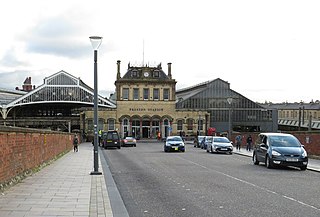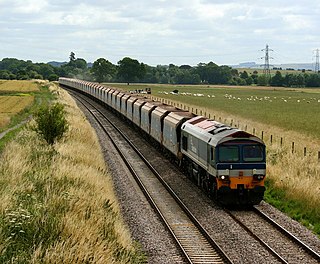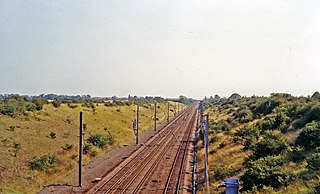
The London and North Western Railway was a British railway company between 1846 and 1922. In the late 19th century, the LNWR was the largest joint stock company in the world.

The Abergele rail disaster took place near Abergele, North Wales, in August 1868. At the time, it was the worst railway disaster to have occurred in Great Britain.

The Charfield railway disaster was a fatal train crash which occurred on 13 October 1928 in the village of Charfield in the English county of Gloucestershire. The London, Midland and Scottish Railway (LMS) Leeds to Bristol night mail train failed to stop at the signals protecting the down refuge siding at Charfield railway station. The weather was misty, but there was not a sufficiently thick fog for the signalman at Charfield to employ fog signalmen. A freight train was in the process of being shunted from the down main line to the siding, and another train of empty goods wagons was passing through the station from the Bristol (up) direction.

Preston railway station, in Preston, Lancashire, England, is an interchange on the West Coast Main Line; it is approximately half-way between London Euston and Glasgow Central. It is served by Avanti West Coast, Northern Trains and TransPennine Express services, plus Caledonian Sleeper overnight services between London and Scotland. It is also served by the Calder Valley line to Leeds and York, and by branch lines to Blackpool North, Ormskirk and Colne.

Mendip Rail Ltd is an independent freight operating railway company in Great Britain. It is a joint venture composed of the rail-operation divisions of Aggregate Industries and Hanson Aggregates.

Penmaenmawr railway station serves the town of Penmaenmawr, Wales, and is located on the North Wales Coast Line between Crewe and Holyhead, 49+1⁄4 miles (79.3 km) west of Chester.

Over the latter years of the 19th and early years of the 20th centuries, Penistone in Yorkshire gained a name as an accident black-spot on Britain's railway network; indeed, it could be said to hold the title of the worst accident black-spot in the country. The main line through the town was the Woodhead route of the Manchester, Sheffield and Lincolnshire Railway between Sheffield Victoria and Manchester, London Road. The line was heavily graded with a summit some 400 yards inside the eastern portal of the Woodhead tunnel.

Chelford railway station serves the village of Chelford in Cheshire, England. The station is a stop on the Crewe to Manchester Line, sited 14+1⁄4 miles (22.9 km) north of Crewe.

The Stechford rail crash occurred on 28 February 1967 at Stechford railway station in the area of Stechford in Birmingham, England.

The Abbots Ripton rail disaster occurred on 21 January 1876 at Abbots Ripton, then in the county of Huntingdonshire, England, on the Great Northern Railway main line, previously thought to be exemplary for railway safety. In the accident, the Special Scotch Express train from Edinburgh to London was involved in a collision, during a blizzard, with a coal train. An express travelling in the other direction then ran into the wreckage. The initial accident was caused by:
There have been a number of train accidents on the railway network of Victoria, Australia. Some of these are listed below.

The London and North Western Railway (LNWR) Waterloo Class was a class of 2-4-0 steam locomotives that was also known as the Whitworth Class.

Great Western Railway accidents include several notable incidents that influenced rail safety in the United Kingdom.
The Kirtlebridge rail crash took place in 1872 at Kirtlebridge railway station in Dumfriesshire. An express passenger train ran into a goods train that was shunting; 11 people lost their lives immediately, and one further person succumbed later. The cause was a failure to communicate between the station master in charge of the shunting operation, and the signalman. There was not full interlocking of the points, and the block system of signalling was not in use.

The London and North Western Railway Experiment Class was a series of 30 three-cylinder 2-(2-2)-0 compound locomotives designed by Francis Webb for the London and North Western Railway between 1882 and 1884. They were Webb’s first large-scale experiment with a class of express compound locomotives, and the first engine was named accordingly. They were followed by a class of similar, but larger locomotives, that featured larger boilers and smaller driving wheels – the LNWR Dreadnought Class.
The St. Neots Derailment 1895 occurred near to St. Neots railway station on 10 November 1895 when a Great Northern Railway Scottish express from Kings Cross encountered a broken rail.

Healey Mills Marshalling Yard was a railway marshalling yard located in the village of Healey, south west of Ossett in West Yorkshire, England. The yard was opened in 1963 and replaced several smaller yards in the area. It was part of the British Transport Commission's Modernisation plan, and so was equipped with a hump to enable the efficient shunting and re-ordering of goods wagons. The yard lost its main reason for existence through the 1970s and 1980s when more trains on the British Rail system became block trains where their wagons required less, or more commonly, no shunting.













